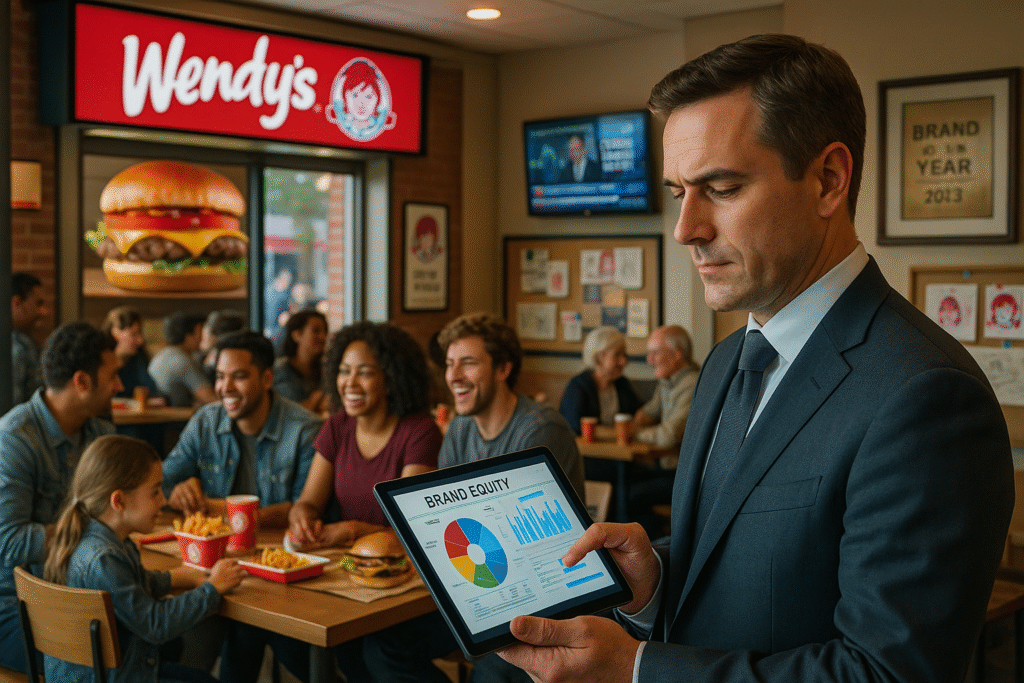Keywords: Wendy’s brand equity, fast food brand value, brand equity calculation, brand valuation methods, restaurant marketing analysis, cost approach, market approach, financial approach, CLV and brand equity, digital marketing, academic marketing project
Introduction: Why Use Wendy’s for Brand Equity Calculation?
For my marketing research project, my professor suggested selecting a well-known fast food chain to analyze brand equity—a vital intangible asset in today’s competitive restaurant industry. I chose Wendy’s because it stands out as an iconic, innovative, and widely recognized brand, making it an excellent example for applying different brand valuation methods.
In this post, you’ll learn what brand equity is, why it matters, and how it can be calculated through several industry-standard approaches. Plus, you’ll see how Customer Lifetime Value (CLV) connects to brand strength, and why Wendy’s is an ideal case for students and marketing professionals alike.
What Is Brand Equity and Why Does It Matter?
Brand equity is the value a strong brand adds to a company’s products and services. It influences customer loyalty, pricing power, competitive advantage, and even long-term financial performance. In fast food, where consumer choices are often made in seconds, brand equity can be the difference between a loyal customer and a missed sale.
For Wendy’s, high brand equity means:
- More loyal customers who return frequently
- Ability to charge premium prices versus generic fast food brands
- Effective marketing ROI and stronger market share
- Resilience in a crowded, price-sensitive market
Three Proven Methods to Calculate Wendy’s Brand Equity
1. Cost Approach
The cost approach calculates brand equity based on the total historical investment required to build and maintain the brand. For Wendy’s, this includes:
- Marketing & Advertising: ~$450 million/year
- Brand Development & Design: ~$50 million (logos, positioning, visual identity)
- Legal & Brand Management: ~$100 million (trademarks, licensing, management)
Total estimated brand-building cost: $600 million
Strengths:
- Conservative; shows minimum value created by past investments
- Useful for understanding the financial commitment needed to create a strong brand
Limitations:
- Ignores the ongoing and future value generated by the brand
2. Market Approach
The market approach compares Wendy’s branded business performance to that of a similar, generic fast food competitor.
- Wendy’s Annual Revenue: $2 billion
- Non-Branded Chain Revenue Estimate: $1.4 billion
Brand premium attributed to Wendy’s:
$2B – $1.4B = $600 million
After adjusting for brand management costs (~$100 million),
Market-based brand equity: $500 million
Strengths:
- Reflects real-world market performance and revenue advantage due to branding
- Easy to communicate to investors and stakeholders
Limitations:
- May undervalue long-term, intangible benefits like loyalty and word-of-mouth
3. Financial Approach
The financial approach uses the Net Present Value (NPV) of future cash flows generated by the brand.
- Projected annual earnings: $2 billion
- Profit margin: 20% → $400 million in yearly profit
- Brand’s contribution (estimated): 60% of profit = $240 million/year
- Discount rate (industry standard): 10%
NPV Calculation:
$240M / 0.10 = $2.4 billion
Strengths:
- Most comprehensive; captures both current and future value of the brand
- Supports strategic decision-making and long-term planning
Limitations:
- Sensitive to future assumptions and market projections
Method Comparison: Which Is Best?
| Method | Brand Equity Estimate | Strength | Limitation |
|---|---|---|---|
| Cost Approach | $600 million | Conservative, based on investments | Ignores future earnings |
| Market Approach | $500 million | Revenue premium, market-based | May miss long-term brand impact |
| Financial Approach | $2.4 billion | Future-focused, comprehensive | Assumptions-sensitive |
Wendy’s brand equity range (2025):
$500 million – $2.4 billion, depending on the method used.
Why the differences?
- The cost approach only captures what was spent, not what the brand can generate.
- The market approach is based on today’s competitive performance.
- The financial approach projects the value Wendy’s brand will create in the years ahead.
The Role of Customer Lifetime Value (CLV) in Brand Equity
Brand equity and Customer Lifetime Value (CLV) go hand in hand. CLV measures the total value a customer brings over their relationship with the brand, and is heavily influenced by branding. A strong brand means:
- Higher retention rates
- More frequent visits
- Greater willingness to spend
For Wendy’s, CLV calculations show:
- Digital customers’ CLV: $150.72
- Traditional customers’ CLV: $30.26
Brands that shift customers to higher-CLV channels (like digital/mobile) can grow both revenue and brand equity significantly.
How CLV helps calculate brand equity:
- Multiply average CLV by the number of customers
- Estimate how much of that value comes from brand loyalty and strength
- Adjust for competitive and market factors
Why Wendy’s Is the Ideal Example for Brand Equity Analysis
- Widely recognized with strong brand identity and customer following
- Publicly available financial and marketing data for accurate calculation
- Competes directly with other industry leaders, making the market approach easy to apply
- Innovative with digital, mobile, and loyalty programs—great for exploring modern CLV and brand equity strategies
Conclusion: Key Takeaways for Marketers and Students
- Multiple methods are needed to understand brand equity from every angle
- Wendy’s brand equity likely ranges from $500 million to $2.4 billion depending on method and market conditions
- Strong brand equity powers loyalty, premium pricing, and growth—even in a competitive space like fast food
- CLV is a crucial part of measuring the “real” value of a brand
- Regularly revisiting brand equity keeps marketing and business strategy on track
References
- CustomerGauge. (2023). Average customer lifetime value by industry
- DoorDash. (2022). Restaurant customer acquisition cost
- Earnest Analytics. (2023). Wendy’s summer late-night traffic increase boosted ticket sizes
- LendingTree. (2023). Fast food survey: How often do Americans eat fast food?
- Restaurant Dive. (2019). Wendy’s expects digital to drive 10% of sales by 2024
- Statista. (2024). Wendy’s restaurant chains brand profile in the United States
- The Wendy’s Company. (2024). Third quarter 2024 results
Author: Ramon Cristian Rocha Silva
Broadwell College of Business and Economics, Fayetteville State University
MKTG 640: Modern Marketing
Disclaimer: Wendy’s is used as a practical example for academic analysis in this project, following the suggestion to study a fast food chain. Brand equity values are estimates for educational purposes.
This long-form post is optimized for: Wendy’s brand equity, fast food brand value, restaurant brand strategy, academic marketing projects, CLV in brand equity, and brand valuation methods.


